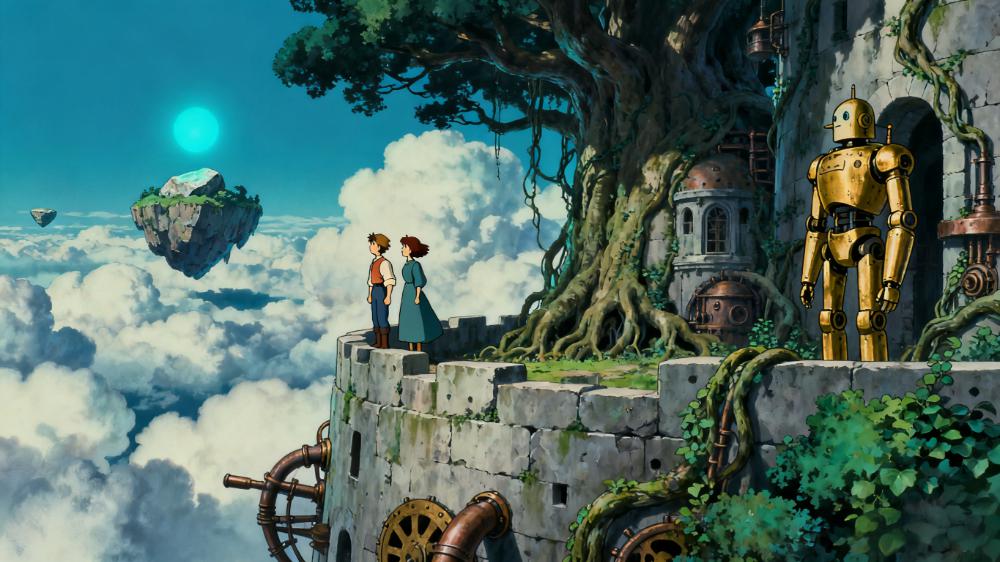The Magic of Theme Melodies: Every Story Has Its Own Voice
Hisaishi's most amazing talent lies in his ability to create unique theme melodies for each story. These melodies aren't just pleasant to hear but are core expressions of the story's emotions. In 'Castle in the Sky,' the theme song 'Castle in the Sky' uses grand symphony to depict Laputa's magnificence and mystery, and when Sheeta and Pazu fly through clouds, the music becomes more ethereal, as if carrying their dreams.
'My Neighbor Totoro's theme song 'My Neighbor Totoro' is completely different, using simple piano melodies to create a warm family atmosphere. When the sisters wait for their father in the rain, the rain sound effects in the music intertwine with piano sounds, creating a warm yet slightly melancholic emotion. This delicate emotional expression allows audiences to feel the characters' inner worlds.
In 'Spirited Away,' Hisaishi takes theme melody usage to the extreme. 'Spirited Away's theme not only runs throughout the film but also undergoes variations at key moments to express different emotional layers. When Chihiro works at the bathhouse, the music becomes busy and tense; when she and Haku fly in the sky, the music becomes free and romantic.
Emotional Colors: How Music Injects Temperature into Visuals
Hisaishi's music isn't just accompaniment to visuals but an expresser of emotions. He can use music to create rich emotional layers, allowing audiences to feel subtle emotions in hearing that visuals cannot convey. In 'Princess Mononoke,' when Ashitaka is cursed, the music uses deep strings to express pain and despair; when he meets San in the forest, the music becomes soft and mysterious, creating a romantic atmosphere of budding love.
The music in 'Kiki's Delivery Service' shows Hisaishi's deep understanding of youthful emotions. When Kiki first leaves home, the music uses light melodies to express anticipation for the future; when she encounters setbacks, the music becomes melancholy and heavy; when she regains confidence, the music becomes cheerful and hopeful again. This emotional fluctuation allows audiences to resonate with Kiki's growth journey.
Even more astonishing is Hisaishi's ability to create communication beyond language with music. In 'Spirited Away,' when Chihiro and No-Face ride the train, the music uses simple piano melodies to express the complex emotions of loneliness and companionship. This wordless communication is deeper than any dialogue.
Cultural Fusion: Perfect Combination of Eastern Aesthetics and Western Music
The most unique aspect of Hisaishi's music lies in his ability to perfectly combine Eastern aesthetics with Western musical techniques. In 'Spirited Away,' he extensively uses traditional Japanese instruments like shakuhachi and shamisen to create a rich Eastern atmosphere. But he also employs Western symphonic techniques, giving the music international expressiveness.
The music in 'Princess Mononoke' shows the depth of this cultural fusion. The film contains both traditional Japanese musical elements like Noh rhythms and folk melodies, and modern Western symphonic techniques. This fusion not only enriches the music's layers but allows audiences to feel the charm of exotic cultures through familiar musical language.
Hisaishi also excels at using different musical styles to express different cultural backgrounds. In 'Nausicaä,' he uses orchestral music to express epic magnificence; in 'My Neighbor Totoro,' he uses folk style to create rural warmth; in 'Kiki's Delivery Service,' he uses jazz elements to express urban vitality.
Inheritance and Innovation: The Era Significance of Hisaishi's Music
Hisaishi's music isn't just Ghibli animation's soundtrack but a milestone in Japanese animation music. His works have influenced an entire generation of animation music creators, elevating animation music from simple background music to an independent art form.
More importantly, Hisaishi's music has transcendent value beyond its era. Even in today's highly developed digital music technology, his works can still touch hearts. This is because his music isn't just a display of technique but an expression of emotion. Every note carries his understanding of life and pursuit of beauty.
On AI art platforms like GhibliAi, Hisaishi's music also provides important inspiration. Technology can imitate musical techniques but cannot replicate musical soul. True artistic creation requires deep understanding of human emotions and sincere pursuit of beauty. Through 40 years of musical creation, Hisaishi tells us that in this era of rapid technological development, we still need to maintain reverence for art and sincerity toward emotions.
